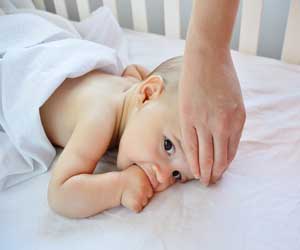- Home
- Editorial
- News
- Practice Guidelines
- Anesthesiology Guidelines
- Cancer Guidelines
- Cardiac Sciences Guidelines
- Critical Care Guidelines
- Dentistry Guidelines
- Dermatology Guidelines
- Diabetes and Endo Guidelines
- Diagnostics Guidelines
- ENT Guidelines
- Featured Practice Guidelines
- Gastroenterology Guidelines
- Geriatrics Guidelines
- Medicine Guidelines
- Nephrology Guidelines
- Neurosciences Guidelines
- Obs and Gynae Guidelines
- Ophthalmology Guidelines
- Orthopaedics Guidelines
- Paediatrics Guidelines
- Psychiatry Guidelines
- Pulmonology Guidelines
- Radiology Guidelines
- Surgery Guidelines
- Urology Guidelines
New clinical score, non invasive method to predict risk of febrile infants in ED

A reliable clinical score could help avoid lumbar puncture and hospitalization in low-risk infants,finds a study.
Abnormal urine analysis, absolute neutrophil count, age and body temperature is sensitive enough to detect infants with a low probability of invasive bacterial infection, revealed a study published in the journal Pediatrics.
The study demonstrated that normal urine analysis and an absolute neutrophil count of more than <5185 cells per μL in the in infants who are more than 60 days old with fever by history only have fewer chances of invasive bacterial infection.
The study was conducted to drive and validate the prediction model for the identification of febrile infants ≤60 days old at low probability of invasive bacterial infection (IBI).
The authors conducted a case-control study of febrile infants ≤60 days old who presented to the emergency departments of 11 hospitals between July 1, 2011, and June 30, 2016. Infants with IBI, defined by the growth of a pathogen in the blood (bacteremia) and/or cerebrospinal fluid (bacterial meningitis), were matched by hospital and date of visit to 2 control patients without IBI. Ill-appearing infants and those with complex chronic conditions were excluded. Predictors of IBI were identified with multiple logistic regression and internally validated with 10-fold cross-validation, and an IBI score was calculated.
A total of 181 infants with IBI with bacteremia without meningitis were included in the study. 26 infants with bacterial meningitis) and 362 control patients were involved in the study. Twenty-three infants with IBI and 138 control patients had a fever by history only.
The regression model identified four indicators of IBM in infants
- Age <21 days (1 point)
- The highest temperature recorded in the emergency department 38.0–38.4°C (2 points) or ≥38.5°C (4 points),
- Absolute neutrophil count of ≥5185 cells per μL (2 points)
- Abnormal urinalysis results (3 points).
The sensitivity and specificity of a score ≥2 were 98.8% and 31.3%, respectively. All 26 infants with meningitis had scores ≥2.
The authors concluded that infants ≤60 days old with fever by history only, a normal urinalysis result, and an absolute neutrophil count <5185 cells per μL have a low probability of IBI.
For further reference, click on the link
https://doi.org/10.1542/peds.2018-3604

Disclaimer: This site is primarily intended for healthcare professionals. Any content/information on this website does not replace the advice of medical and/or health professionals and should not be construed as medical/diagnostic advice/endorsement or prescription. Use of this site is subject to our terms of use, privacy policy, advertisement policy. © 2020 Minerva Medical Treatment Pvt Ltd